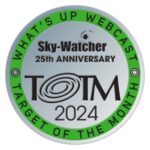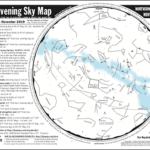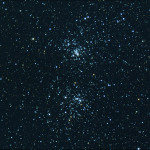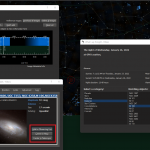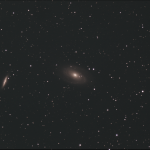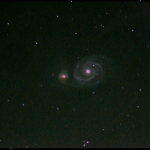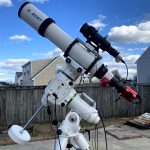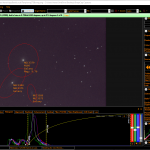
There are countless (thousands, 10s of thousands, millions, billions) objects in the night sky. There are many object catalogs (NGC, Messier, IC, Caldwell, Barnard, LBN, PGC, UGC, Abell, etc…). Not all of these objects and catalogs are available in every planetarium program, at least not by default. Even with the many hundreds (or thousands) of catalog objects that may be up in the sky at any given time… sometimes you will find yourself asking yourself… What should I look at?
Or is that just me?
I wrote a post some time ago on planning observing sessions using KStars to create an observation wish list and another on using Wikipedia to plan an EAA session. In this post I am providing details and links to a few different online communities and resources that I use which provide great monthly challenges and other information on what’s up in the sky during a particular month.
Monthly observing challenges, regular columns, and forums which can help you either plan your next observing session or turn you on to something you may not have seen (or even knew existed) before.
- CloudyNights’ Electronically Assisted Astronomy (EAA) Forum Monthly EAA Challenge
Each month a CloudyNights’ EAA Forum Member post a list of objects. Some are relatively easy others are more challenging, all can be viewed in that month’s night sky. Read the forum rules for what is considered EAA. Basically it means there can be no post processing of the image but there are other rules around exposure length and live stack duration. Check the forum each month, grab the target list, EAA observe, and share your results. This is a great way to get some great targets to observe, to learn more about EAA, and to help improve your electronic assisted observing.
Check the forum each month, grab the target list, EAA observe, and share your results. This is a great way to get some great targets to observe, to learn more about EAA, and to help improve your electronic assisted observing. - CloudyNights’ Beginning Deep Sky Forum Goofi’s Monthly Imaging Challenge
This one is for beginning astrophotography, a different deep sky object each month. Each month there is an associated thread to discuss image acquisition and processing techniques. There is a nice challenge library which list all the past challenge objects, so plenty to keep you busy for a bit. Share your results, view the results from others, and learn more about image acquisition and image processing. - Sky-Watcher USA Target of the Month (TOTM)
I discovered this one recently. The TOTM is announced at the beginning of each month LIVE on the Sky-Watcher What’s Up? Webcast, website, social media, and e-newsletter. There have been some objects on the list that don’t usually show up (by default) in most planetarium programs. Most of these objects are a bit more challenge… but there is potentially a reward if you are successful. Check out the TOTM, give it a try, follow the rules for submitting it, and maybe earn yourself a cool patch for your efforts.
I am sharing my 2024 Sky-Watcher TOTM submissions here.
- The Sky Searchers – Monthly DSO Challenge
This is another one that I just stumbled upon recently. This Monthly Deep Sky Object (DSO) challenge provides a great list of objects visible during the month in both the Northern and Southern hemisphere, so there is a little something for everyone. Not only does the challenge contain a great list of objects but there is a good amount of information and detail on each object. Sharing and discussing your observations is encourage. - Night Sky Network – Night Sky Planner
This page is a great place beginners, or for people who just enjoy looking up at night. A feature of what is visible in the night sky during the month along with weather, Moon, and Sun data. Just put in your zip code to see what’s happening in your sky. The What’s Up Skywatching Tips from NASA video at the bottom of the page provides some great information on things you can see during the month… no astronomy gear required. - Skymaps.com The Evening Sky Map
Let’s go old school. A monthly guide to the night sky. A 2-page PDF released every month with a nice sky map and information on astronomical events happening during the month, on objects visible to the naked eye, through binoculars, and through a telescope. Monthly sky maps editions include maps for the northern hemisphere, the southern hemisphere, and an equatorial edition for observers along the equator. These are a great way to learn the night sky. - Phil Harrington’s Cosmic Challenge
Phill Harrington has authored a bookshelf full of great astronomy books and writes regular columns for different astronomy publications. This is a great monthly column by Phil Harrington on CloudyNights where: “Each month, we will look for objects that, quite honestly, many amateurs don’t even know exist!” Along with the object there are details on the best equipment to use to observe the object, sky charts, sketches, and photos. Great articles, interesting, and challenging objects. Challenges for observing with the naked eye, through binoculars, and all sizes of backyard telescopes.
- SpaceWeather.com Information about the Sun-Earth environment
If you are into solar, comet, or near Earth asteroid observing then SpaceWeather.com is a great resource. This is a near real-time resource with updates on sunspots, solar flares, auroras, comets, and Potentially Hazardous Asteroids (PHAs). - Night Skies Network
So this is not an object list or challenge, but if you want to see what other folks are looking at… this is the place to actually see what others are looking at. Whether the skies are cloudy where you are or you don’t even own a telescope; Night Skies Network provides a platform for amateur astronomers to broadcast their observing and imaging sessions. There is someone on there almost every night, and sometimes during the day, broadcasting views of the sky. It’s a great place to watch and everyone is happy to share tips and tricks.
Night Skies Network provides a platform for amateur astronomers to broadcast their observing and imaging sessions. There is someone on there almost every night, and sometimes during the day, broadcasting views of the sky. It’s a great place to watch and everyone is happy to share tips and tricks.
When I come across an interesting target which I have not observed in the past I try to remember to post it here: Future Interesting Targets.
There is always something interesting to see.
What resources do you use to plan your observing sessions? Do you participate in an monthly observing challenges? Please drop them in the comments below.

